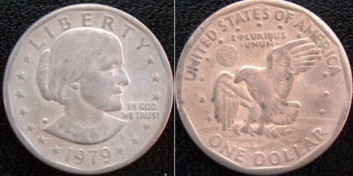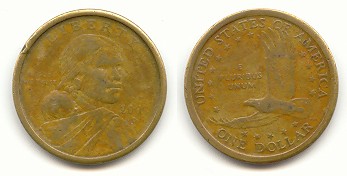
COUNTERFEIT 1979-D ANTHONY DOLLAR

COUNTERFEIT 2000-D SACAGAWEA
DOLLAR
ANTHONY
AND SACAGAWEA |
|
|
With the dollars low buying power in today's world, one would have to wonder why anyone would want to counterfeit an Anthony or Sacagawea Dollar. It just seems that after buying the machinery and material, making the dies and planchets, striking the coins, and then going through the risky business of distributing the counterfeits, that it just wouldn't be profitable. Nevertheless, it is done.
This reminds me of the "Hennings Nickels" of the 1950's. A man named Francis Hennings decided to counterfeit the 5˘ piece. His thinking was that no one would pay much attention to them. Afterall, who in the world would take the time to counterfeit a Nickel. Counterfeiters generally spent their time counterfeiting Twenty, Fifty, and Hundred Dollar bills. He created an incredible product. In fact, initially the U.S. Mint had authenticated them. His counterfeit Nickels would have probably never been detected and he would have probably never been caught if he hadn't made one little mistake. Coin collectors noticed that on some 1944 dated nickels that the "P" mint mark was missing. The "War Nickels" of 1942-1945 had a large mint mark (P,D,or S) added to the reverse to note the metal content change of those years. Eventually Mr. Hennings was captured and convicted for counterfeiting the coins. After his capture, Mr. Hennings commented that after buying all of the machinery and materials he needed that he had actually lost money on the venture.
The Sacagawea Dollar widely circulates in several South and Central American countries. In 2002, a major counterfeiting plot was discovered in Bogotá, Columbia. As many as one half to one million counterfeit coins were struck there for use in Ecuador. The counterfeit coin's diameter, thickness, and weight are within tolerance of genuine Sacagawea Dollars, but are not made of the three-layer sandwich material that genuine pieces are made of. In addition, instead of a golden color, the counterfeits have more of a copper color.